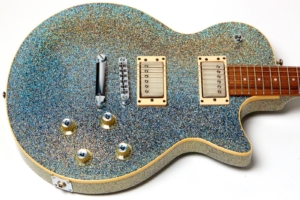
Fair warning: this is a long review, and while there’s no math, prepare to be dazzled with science while being dazzled by the guitar.
Introduction
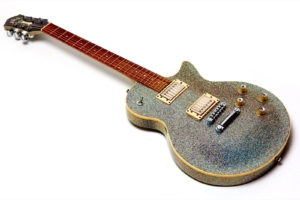
Let me say this from the start: If you have compelling evidence to the contrary of what you’re about to read, please do leave a comment or email me and I’ll update this article if the data proves your point. I’m always happy to be proven wrong provided you do so respectfully. Please also understand that what I’m including here is based on actual documentation and conversations with experts who know far more about Guild guitars than I do. With that having been written, let’s start with a zinger:
These are just regular Bluesbirds
OK, so that’s not 100% true because Bluesbirds have bound fretboards with block inlays, so these are certainly different in that regard, but aside from that the guitar is just a Bluesbird.
If you look at the NAMM flyer shown here. you’ll see the model number as 360-6400-850. According to the 2002 price list, The model number for the standard Bluesbird (literally the Bluesbird STD) is 360-6400. The Bluesbird AAA, which came with a AAA maple top, also has the same model number, but since the AAA came in different finishes than the STD, I imagine they thought that differentiating based on finish made sense since certain finishes were only available on the AAA models while others only showed up on the STD. The -850 suffix is the code for the finish on this guitar, but it does not necessarily mean Black Holoflake. More on that in a minute.
It’s a bit odd that the sheet from NAMM (shown here) lists the top as being a Carved Figured Maple Top and while I could lament them using a beautiful piece of flamed maple to spray all that sparkle over, I have to imagine that this is a typo or incorrectly copy/pasted text and that they used Bluesbird STD bodies. Bluesbirds are described in the 2002 price list as having a carved maple top with the figured carved maple top being reserved for the Bluesbird AAA. It is possible, I should point out, that there is a AAA top under all that sparkly goodness, but I’m not going to be the one to strip one of these rare guitars in order to find out. It also wouldn’t surprise me if Guild had a pile of AAA Bluesbirds with finish problems or blemishes in the wood that they chose to refinish since they’ve done exactly that in the past with other models. Thus, until definitive proof can be shown either way, I’d judge the inclusion of a Carved Figured Maple Top on these models as plausible.
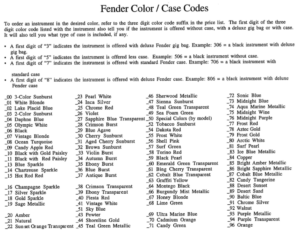
To further confuse matters, Guild changed all their color codes right around the time that this guitar was being sold. For example in 2001 Black had the code _06 and 806 meant that it came with a deluxe case (2001 price list) while a 2002 Bluesbird in black would have an -820 suffix, so it’s no wonder everyone is confused. This change appears to have been in order to align the color codes with Fender’s schemes. In the price guide _50 is for Special Colors (by model) and as stated above the 8__ means deluxe case, which is how we get the -850 suffix. It’s a Bluesbird (360-6400-850) in a deluxe case (360-6400-850) with a special color (360-6400-850). If you custom ordered a Bluesbird in 2002 with a Transparent Blue finish, I imagine that it would have the same model number.
On to myth #2:
These are not NAMM Guitars
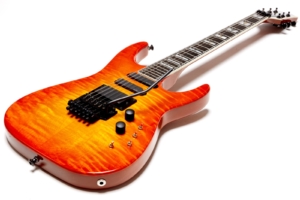
See the flamed orange super Strat pictured here? That is a Guild X4000 and is one of only two that I know of, both of which were made to show at NAMM (yes, a review is pending) and both of which have FFxxxxxx prototype serial numbers. That X4000 is a NAMM Guitar, and NAMM Guitars (at least from what I’ve seen from Guild) tend to be one or two of a kind which was not the case with these Holoflake Guilds. These are limited edition guitars that were shown at NAMM, not NAMM Guitars.
But, they’re Custom Shop guitars, right?
These are not Custom Shop Guitars
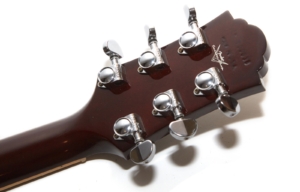
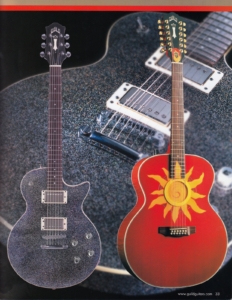
I think this confusion may be in part due to the fact that the Custom Shop pages in the 2003 catalog shows this model along with the very vague statement, Our popular electric Bluesbird model got a tailored Black Holoflake finish, inspired by the one-of-a-kind built for Steve Marker of Garbage (see page 42). To make matters worse, page 42 of that catalog has nothing to do with electric guitars, let alone this Bluesbird or even Steve Marker. I thought that maybe this was a holdover from the previous year’s catalog, but the 2002 Guild catalog only has 30 pages. It’s tempting to use guitar catalogs as a source of truth, but it’s amazing how many inaccuracies you find when you dig a bit.
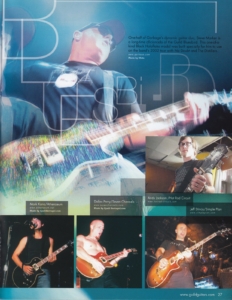
I’ve also seen many people repeat something to the effect that these guitars were made to celebrate Fender taking over Guild (which happened 7-8 years prior) or for Fender moving production to Corona (which is more likely), but then I’ve seen people claim their Bluesbird Holoflake was a 2001, 2002, or 2003, so take anything you read in a for sale ad regarding these guitars with a grain of salt. Still, the idea that they were made to celebrate something is plausible, so I can’t dismiss that one outright.
As for how many were made, I couldn’t say. I’ve read that only 17 of the planned 35 were made, but I don’t have access to records to prove or disprove any of that, so I’ll take it at face value that there were 35 made unless someone can prove otherwise. They do seem to be pretty uncommon which I would expect from a limited edition guitar.
Show me Some Videos, Dammit!
You can see Steve’s custom single-pickup Bluesbird Holoflake In this Youtube video where you can also see Duke Erikson’s (also from Garbage) nice ’90s Starfire III. As an aside they both make statements that Guild is no longer making electric guitars and the comments on that video are filled with, “Guild makes electric guitars!” but you have to remember that the video was posted in April of 2013 and Guild had just introduced the Newark St. line in January of that year so they probably just didn’t know about them yet, or like many of us, they didn’t take the import Newark St. guitars as seriously as the older US-made versions. I think they would have said something to that effect had they known, though.
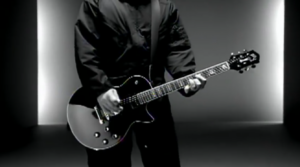
Finally, I did find another very cool video where the band is rehearsing I Think I’m Paranoid, this time with Steve Marker playing his custom shop Holoflake Bluesbird.
Whew! With all that out of the way, let’s take a look at this guitar.
The case
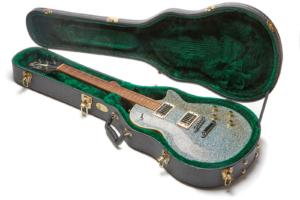
Finish
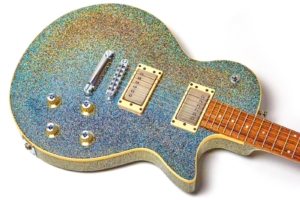
The flyer from NAMM says Holo-Flake, but every word is capitalized on that sheet which is a bit odd. The 2003 catalog says Holoflake. The price guides… Well they don’t say anything about it for reasons explained in the introduction. After far too much research looking for patents and trademarks, I believe that Holoflake is a product of Spectratek who offers Geometric Pigment and Holoflake Holographic Glitter to the cosmetics, paint and plastic packaging industries. Although I couldn’t find any current trademark (I did find this cancelled one) I’ve decided to standardize on Holoflake.
Every surface of the guitar is covered in Holoflake and finished in gloss polyurethane with the exception of the binding, the fretboard, and the headstock veneer. Even the back of the neck and the back of the headstock is Holoflake which makes it a bit of a challenge to read the serial number, but I’ll get to that later on.
The finish has two major effects that pop out when you see it. First, it quite obviously sparkles. In photography we call bright spots of light on shiny objects specular highlights, and this guitar makes a lot of ’em. Second, it refracts light in each one of those specular highlights into a rainbow where the primary color seen varies based on your position in relation to the individual flake along with the angle of incidence of the light source.
Um… what?
It makes rainbow sparkles. Because it’s Holoflake. Duh.
What is Holoflake?
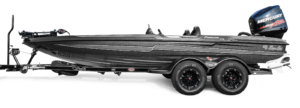
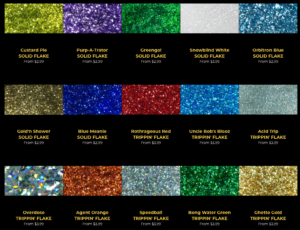
While metal flake is very cool, that’s not what’s on this guitar; this guitar’s finish is called Black Holoflake. While the Holoflake finish is made with the same technique, instead of using metal flakes, the flakes are of holographic film. What is holographic film you ask? Buckle up and learn why my reviews take so damn long.
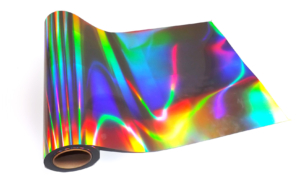
In short, metal-flake will reflect light from each flake (the ones in the correct orientation, anyway) and will give a sparkle to whatever color it’s based on. Put another way, think about a roll of aluminum foil (aluminium for you Brits). The roll of foil is silver, and thus reflects light like a mirror (if polished smooth) so you don’t see rainbows in the reflections, but rather full-spectrum white light instead. If you were to make red (or green or blue, etc.) foil you’d see red (or green, or blue, etc.) reflections as you might imagine.
By contrast, a roll of holographic foil like this one from Indiamart.com reflects and refracts the light (like a prism) instead of just reflecting it (like a mirror) which is what gives it the rainbow sheen seen in the pics. Where it gets more complicated is the fact that this rainbow effect changes based on your orientation to the material and to the light source.
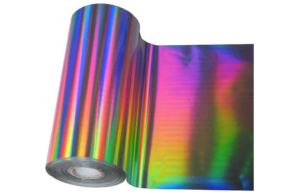
Photographing A Holoflake Guitar
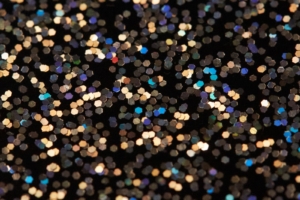
Of course as I wrote earlier they’re not just mirrors because they refract white light into its composite colors. Part of the problem is that the camera then tries to focus those light points and in doing so reassembles the colors into white pinpoints. Why? Because the guitar is creating something that the lens designers consider to be chromatic aberration.
Here comes some science! I swear we’re almost done.
A Brief Physics Tangent
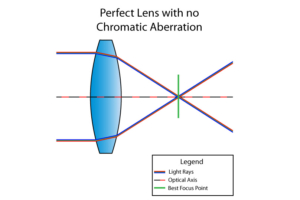
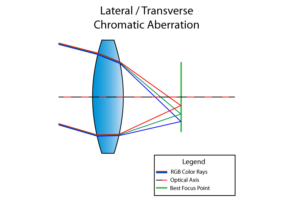
Now, where things get weird is that good camera lenses are designed to prevent chromatic aberration by using expensive lens elements to focus all of the different colors unto the same focal plane. Where things get weirder is the fact that we generally don’t have perfect vision, and so when we look at the guitar we see sparkling slightly out of focus dazzling colors, but the camera tries its damndest to get rid of all those colors (because they’re aberrations) and tries to focus as perfectly as possible.
Why the lesson? (I swear, we’re almost done!)
A Quick Photography Disclaimer
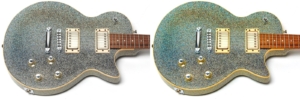

Normally the part of my write-ups that takes the most time is the writing and editing, but for this article the task that consumed the most time by far was trying to get the guitar to look even a third as amazing as it does in real life. When you see people selling these guitars and they say that the pictures don’t do it justice, they are not kidding. In real life, the guitar’s finish is vibrant and very colorful with the rainbow effect changing with every movement of the guitar. Couple that with some bright stage lights and it would be crazy cool on stage.
Back to the guitar
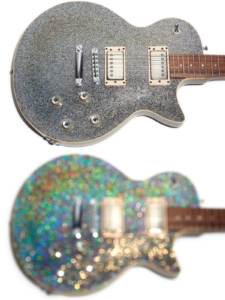
On the bottom image I turned off autofocus and manually turned the focus ring so that the guitar was blurry. I’m not joking when I say that those colors are what you see when you have the guitar in front of you, and this is why every ad for these guitars you’ll see will have a disclaimer stating that the photos don’t do it justice, but we’re getting there. The guitar is absolutely dazzling in person.
Oh, and remember that catalog page with Steve Marker from the introduction? Now you know why it’s out of focus.
I tried for days to get pics of this guitar that represented how it looks in person, and I did manage some good shots in the end, but in order to get the pics to show those dazzling colors the guitar must be partially out of focus (shallow depth of field) which is not what review photos should be. This frustrated me like you wouldn’t believe.
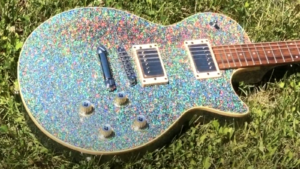
The only way I’ve been able to convey the guitar’s hypnotic brilliance is through video, and high-definition video at that. The first video, which you can see by clicking on the photo of guitar face up in the grass (or by using this link) is of the guitar in the sun. Lest you think I’ve resorted to some digital trickery, I assure you that I have not. The guitar actually looks like this in person, and you’d be tempted to check if it’s been covered by Swavroski crystals when you first gaze upon its magnificence.
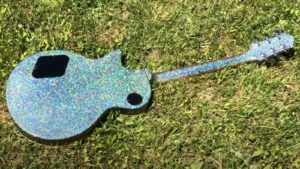
Fretboard and Neck
While Steve Marker’s original single pickup Holoflake Bluesbird has a bound neck with block inlays, these guitars do not, and that’s my first complaint with the design of this guitar. Since most other Bluesbirds (except for the Blues-90) have bound fretboards and blocks, I think this one looks odd without them. It doesn’t affect playability at all since the fretboard edge is wonderfully smooth and the fretwork is excellent, but for a limited edition guitar that’s all about showing off, I’m quite surprised that they used an unbound neck and dot inlays.
The neck is wonderfully wide measuring a solid 1 3/4″ at the nut, but it’s not crazy deep measuring a respectable .86″ at the first fret. I have guitars that are .9″ at the first fret and the difference is profound. While I would call this one a fair bit chunky, I wouldn’t quite call it a fat neck. The scale length is a typical 24¾”.
The fretboard radius is 12″ just like a Les Paul or other Bluesbird from this time period. The fretboard has a bit more character than I’d prefer since I like my fretboards to be as dark as possible, but then this isn’t a guitar that aims to look like all the rest, so a bit of character in the fretboard goes pretty much unnoticed while shielding your eyes from the dazzling rainbow sparkles.
The frets measure .100″ wide by .05″ high making them jumbos. The fret ends are wonderfully smooth and the guitar neck as a whole feels like a dream.
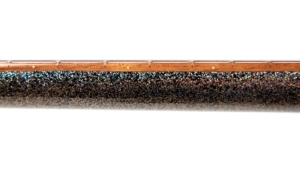
Build Quality
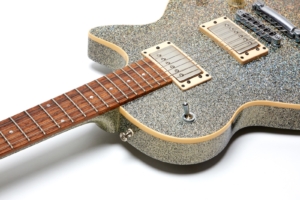
The guitar body is bound on the front with a simple white or cream-colored binding that I think would look a lot more well balanced if the neck was bound, too.
This guitar weighs 7lbs 14oz (3.57 kg) making it just 2oz shy of eight pounds. Though mostly hollow, the guitar isn’t super-light like a hollowbody Starfire III, but also isn’t a boat anchor like some Les Pauls I’ve played.
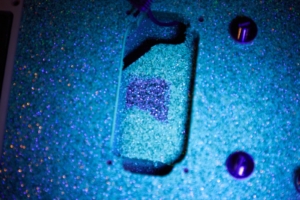
As you’ll see in the next section, the neck pickup route has its own surprise.
Pickups
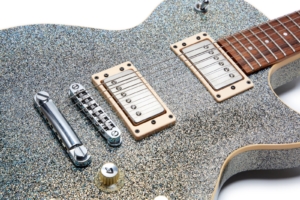
The SH1 pickups are also called the 1959s by Seymour Duncan, and the marketing says, The Seymour Duncan SH-1 ’59 Model Electric Guitar Pickup is built with the same kind of enameled wire, nickel-plated studs, and balanced coil windings that humbucker inventor Seth Lover used in his first pickups. It looks and sounds just like a ’59. What they’re trying hard not to say is that it’s supposed to be a Gibson PAF copy.
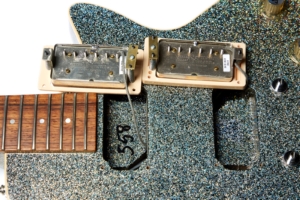
By the way, if you have one of these and you can’t read the serial number because of the blinding Holoflake finish, try pulling the neck pickup where you may well be greeted by a nice surprise. I don’t know if this is only on mine, but the last three digits of the serial number are written in what looks like sharpie or more likely black paint.
Electronics
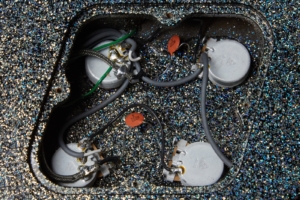
Remember, this is a Fender-era Guild, and Fender is a big company who likes to save money in the name of profits, so the parts are not what I’d call boutique by any stretch though they’re not crap, either.
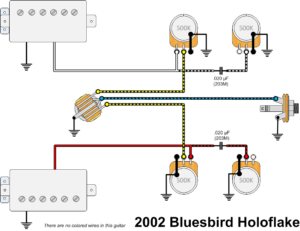
There’s really not much else to say about the electronics other than they’re pretty straightforward and work as they should.
Hardware
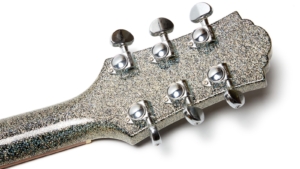
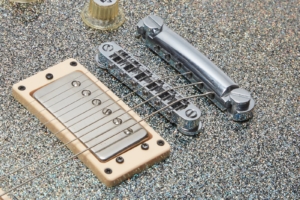
Again, there is nothing special about this guitar aside from the finish and the lack of binding on the fretboard. It’s a Bluesbird like any other non-custom-shop Bluesbird from the Corona plant.
Sound
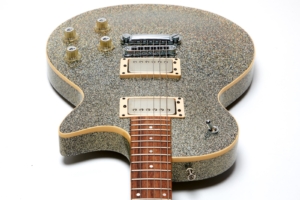
OK, that can’t be the end because I have space to fill in this section, so let’s talk some detail. I keep saying that this is just another Bluesbird, but that’s because it is. From the pickups to the capacitors it’s the same damn guitar as my other Bluesbirds from the same era and if you don’t believe me go buy a bunch and see for yourself. Sure, that’s irrational, but that’s what I did and that’s the conclusion I came to. Still, the guitar sounds amazing and that’s because all these turn of the century Bluesbirds sound amazing. This one just looks cooler.
ODS100 Clean
Open Chords #1
Open Chords #2
D-Shape
7th Chords
JCM-800
A Barre Chords
D-Shape
AC-20
Woman Tone Wankery
For each recording I cycle through the neck pickup, both pickups, and finally the bridge pickup. All knobs on the guitar are on 10 at all times.
Well, not always.
The last recording is named Woman Tone Wankery, presented with clams and all, and is played through the AxeFX III’s AC20 (a Morgan AC20 Deluxe) which is a very popular EL-84 equipped 20 watts boutique amplifier that looks like a mini Plexi. It’s based on a Vox, and according to many: far superior. On this recording I’m playing the neck pickup with the tone rolled down which is a rarity for me, but man do I think it sounds good.
I’ve seen people selling these guitars use all sorts of hyperbole, praising them as sounding better than any other Bluesbird or having some sort of magic or mojo, likely due to them being custom shop guitars (which again, they are not). Honestly, I don’t hear it. That’s not to say that the guitar sounds bad. Hell, I think it sounds great! But then I think all Bluesbirds from this era sound great. The pickups can be a bit dark for some, but there’s nothing special about them when compared to a “regular” Bluesbird.
If there’s magic to be had in this guitar, it’s the presence of the finish under bright stage lights, and let’s be honest: we all know that we sound better when we look better.
Playability
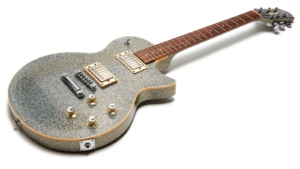
As I wrote in the Fretboard and Neck section, the side markers are very difficult to see, but aside from that and being a little bit butt-heavy, it’s plays as you’d expect it to. If you’ve ever played a Corona-era Bluesbird or even a late ’90s Westerly Bluesbird, then you know what this one feels like. If you don’t, then I’m here to tell you that they’re great guitars, and this one has a nice wide well-shaped neck to boot.
Conclusion
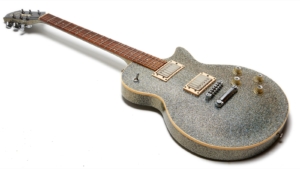
I’m a Les Paul guy who currently owns three Custom Shop models (two R9s and an R7), and if financial hardship hit and I had to sell them all I’d have absolutely zero problem keeping a Bluesbird in their stead. Hell I got my ’97 Bluesbird for $800 and it’s a monster!
These Holoflakes sell for a lot of money these days, but I see stories online about people getting them for much less in the not too distant past. Are they worth the premium? From a playability standpoint, no, at least not in my opinion. They’re not custom shop guitars no matter what some Ebay or Reverb ad says, but they were limited and they are fairly rare. Really, they’re just Bluesbirds with a sexy paint job and no binding. Are they great guitars? Yes! But then every Bluesbird I’ve played has been a great guitar. When it comes to tone and playability, this guitar does not outperform my 1997 Bluesbird that I got for almost 1/3 the price.
If I wanted to complain about something I kind of wish it had a bound fretboard like all the other Bluesbirds from this era and the previous years going back to the late-90s. Calling this one a Bluesbird while making it look like a Blues-90 is just weird, but then Guild has never been good at naming things. A bound fretboard would have the added benefit of making the fret markers visible, too. Shine a spotlight on this guitar and no one will even look at the fretboard, though.
Hopefully you saw in my pics and video that these guitars look absolutely amazing. I’ll leave it for you to decide if that incredible finish is worth the money, but I can tell you that every single person I’ve shown it to has been floored by the guitar and I’ve probably been told 20 times to never sell it. Even my wife who couldn’t care less about guitars told me it was pretty.
This is not a shy person’s guitar. This is a guitar that centers the attention on you when you’re playing it. If that’s what you’re after, you can’t go wrong with a Holoflake Bluesbird. Just don’t call it a Custom-Shop NAMM guitar.
Donate: PayPal Crypto:
ETH: 0x0AC57f8e0A49dc06Ed4f7926d169342ec4FCd461
Doge: DFWpLqMr6QF67t4wRzvTtNd8UDwjGTQBGs

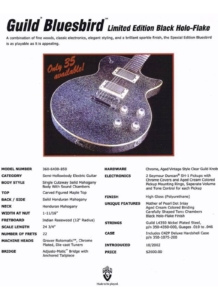
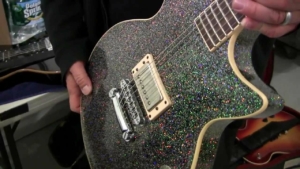
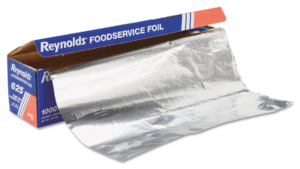
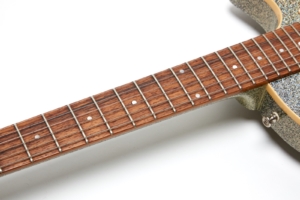

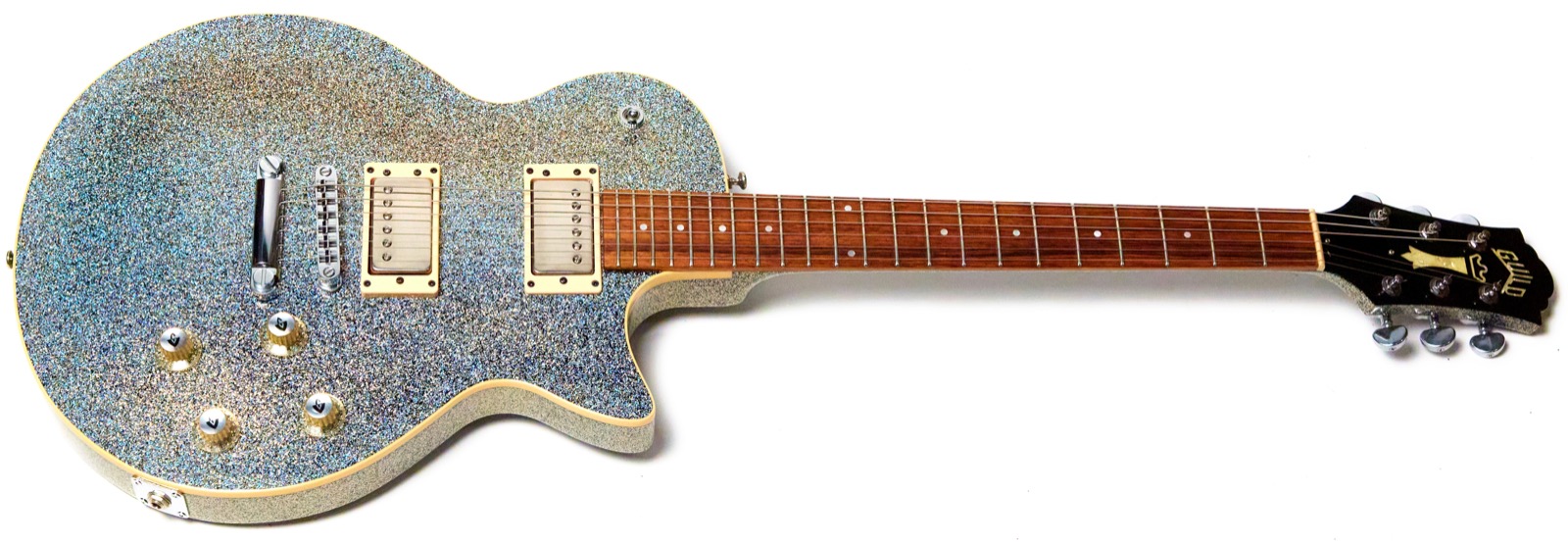

I have one of the guitars that, I believe anyway, was one of the protos for Steve Marker. It’s a single p’up, certified custom shop model (Chris Fleming master build) with natural mahogany back and sides, and the holoflake finish on the front. The block fret markers are also holoflake, and there’s a thin “racing stripe” of holoflake between the rosewood fingerboard and the binding. Unlike the one he plays on stage, this one has a tone knob as well. Haven’t seen much about these in the past couple of years, loved your post, thought I’d share. Hit me up if you want some pics.
Yes please! Email is gad@gad.net.